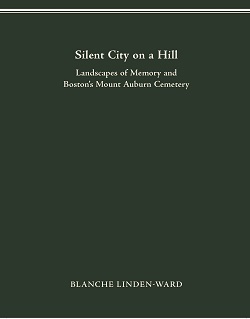Silent City on a HillLandscapes of Memory and Boston’s Mount Auburn CemeteryBlanche Linden-WardUrban Life and Urban Landscape |
 9/9/1989 403 pp. 8.5x11  $37.95 paper 978-0-8142-5335-9 Add paper to shopping cart Shopping Cart Instructions Review/Change Shopping Cart & Check-out | |||
|
|
The group of prominent Bostonians who founded Mount Auburn in 1831 had many motives. Although their criticism of urban burials in the name of public health had been to no avail in obtaining public support, the removal of new burials from the center of the expanding city eliminated a particularly bothersome nuisance to real estate developers and urban boosters. By creating a picturesque “rural” cemetery within easy distance from the city center, Mount Auburn’s founders solved an urban land use problem while establishing a multifunctional cultural institution where they could attempt to improve experimental horticulture, cultivate taste for fine art and architecture, and, most importantly, shape a usable past in the aesthetic terms then in international vogue. Silent City on a Hill traces Mount Auburn’s inception, development, and influence on the urban cemetery and landscape movements, and its many illustrations show what the original visitors to the cemetery saw. The crusade to shape a new usable past in the eighteenth century and early nineteenth century had material as well as literary manifestations, influencing the design of English gardens, the decision to establish Père Lachaise Cemetery outside Paris, the appearance of America’s first patriotic monuments, and, finally, the founding of Mount Auburn. These physical landscapes of memory remain today as evidence of the intellectual and cultural history of the era. Mount Auburn’s significance cannot be understood simply in terms of taste or design, nor simply within the context of Boston in the 1820s and 1830s. It was the product of much larger trends involving changing sensibilities about death, the past, and nature that had been occurring throughout North Atlantic civilizations over the course of the eighteenth century. This cultural revolution was a corollary of political and religious revolutions. Its followers advocated a secular moral philosophy based on reason, and they delighted in the sobering influences of melancholy contemplation stirred by ruins or monuments set in a place of nature. Throughout the 1830s, 1840s, and 1850s, urban leaders across America avidly copied Mount Auburn, using it as a prototype that not only contributed to the “rural” cemetery movement but that also influenced the design of other landscapes. As Mount Auburn captured the public imagination, rural cemeteries became the rage, attracting tourists and inspiring an era of popular culture centered on the sentimentalization or “domestication” of death. About 1870 the cemetery lost the style and original intention of its founders, as modernism replaced Romanticism, prescribing a denial of death. The public began flocking to recreation areas fashioned after the old cemeteries but free of the unpleasantness of graves. Public parks, natural landscapes, and new urban institutions such as museums and arboretums assumed the role formerly played by the landscape cemeteries. Still, Mount Auburn endured and endures, a monument to the importance of the landscape design movement in American urban development. Blanche Linden-Ward is Assistant Professor and Coordinator of the American Culture and Communication Program at Emerson College. | |||

